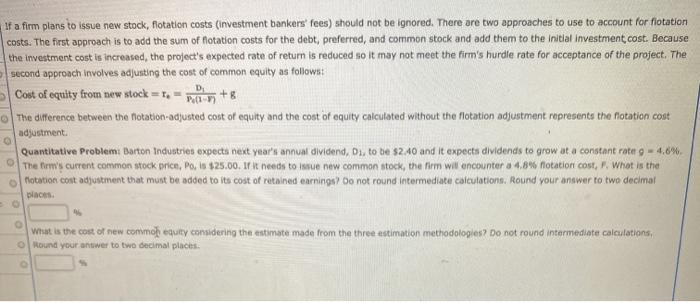If a firm plans to issue new stock, flotation costs (Investment bankers' fees) should not be ignored. There are two approaches to use to account for flotation costs. The first approach is to add the sum of rotation costs for the debt, preferred, and common stock and add them to the initial investment cost. Because the investment cost is increased, the project's expected rate of return is reduced so it may not meet the firm's hurdle rate for acceptance of the project. The second approach involves adjusting the cost of common equity as follows: Cost of equity from new stock=1 was,+8 The allerence between the Motation-adjusted cost of equity and the cost of equity calculated without the flotation adjustment represents the flotation cost adjustment Quantitative Problem: Barton Industries expects next year's annual dividend, Di, to be $2.40 and it expects dividends to grow at a constant rate 9 -4,6% The firm's current common stock price, Pots $25.00. If it needs to issue new common stock, the firm will encounter a 4,8% flotation cost, What is the rotation cost adjustment that must be added to its cost of retained earnings? Do not round Intermediate calculations. Round your answer to two decimal places What is the cost of new commof equity considering the estimate made from the three estimation methodologies? Do not round intermediate calculations, Round your answer to two decimal places Quantitative Problem: Bellinger Industries is considering two projects for inclusion in its capital budget, and you have been asked to do the analysis. Both projects' after-tax cash flows are shown on the time line below. Depreciation, salvage values, net operating working capital requirements, and tax effects are all included in these cash flows. Both projects have 4-year lives, and they have risk characteristics similar to the firm's average project. Bellinger's WACC IS 9% 0 1 2 3 4 Project A -1,100 700 410 200 250 Project B -1,100 300 345 350 700 What is Project A's payback? Do not round Intermediate calculations. Round your answer to four decimal places, years What is Project A's discounted payback? Do not round Intermediate calculations. Round your answer to four decimal places. years What is Project B's payback? Do not round intermediate calculations. Round your answer to four decimal places. years What is Project B's discounted payback? Do not round intermediate calculations. Round your answer to four decimal places. year The firm's target capital structure is the mix of debt, preferred stock, and common equity the firm plans to raise funds for its future projects. The target proportions of debt, preferred stock, and common equity, along with the cost of these components, are used to calculate the firm's weighted average cost of capital (WACC). If the firm will not have to issue new common stock, then the cost of retained earnings is used in the firm's WACC calculation, However, the firm will have to issue new common stock, the cost of new common stock should be used in the firm's WACC calculation Quantitative Problem: Barton Industries expects that its target capital structure for raising funds in the future for its capital budget will consist of 40% debt. 5% preferred stock, and 55% common equity. Note that the firm's marginal tax rate is 25%. Assume that the firm's cost of debt, ra 1 9.8%, the firm's cost of preferred stock, ro, is 9.0% and the firm's cost of equity is 12,4% for old equity, fa, and 12.7% for new equity, re. What is the firm's weighted average cost of capital (WACC) if it uses retained earnings as its source of common equity? Do not round intermediate calculations, Round your answer to two decimal places. What is the firm's weighted average cost of capital (WACC) if it has to issue new common stockDo not round Intermediate calculations. Round your answer to two decimal places









